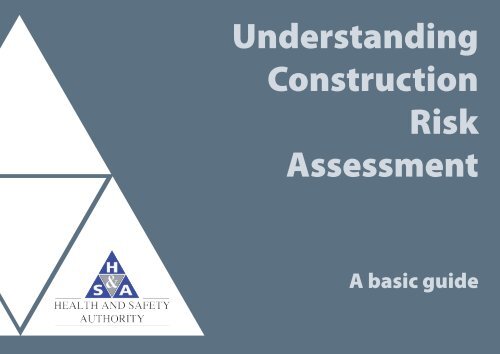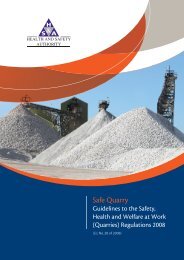Understanding Construction Risk Assessment - Health and Safety ...
Understanding Construction Risk Assessment - Health and Safety ...
Understanding Construction Risk Assessment - Health and Safety ...
You also want an ePaper? Increase the reach of your titles
YUMPU automatically turns print PDFs into web optimized ePapers that Google loves.
<strong>Underst<strong>and</strong>ing</strong><br />
<strong>Construction</strong><br />
<strong>Risk</strong><br />
<strong>Assessment</strong><br />
A basic guide
<strong>Underst<strong>and</strong>ing</strong> risk assessments<br />
You, as the employer, are the one who st<strong>and</strong>s between your workers <strong>and</strong> an accident!<br />
• Look at what can<br />
hurt you or your<br />
workers;<br />
• Decide what you<br />
are going to do;<br />
• Write down what<br />
you are going to<br />
do;<br />
• Tell your workers;<br />
• Do it!
A short guide to risk assessments<br />
The following pages include examples of dangerous situations on site <strong>and</strong> how you can manage similar situations to protect the<br />
health <strong>and</strong> safety of your employees.<br />
Undertaking risk assessments is not difficult! In essence it requires you to look at your workplace <strong>and</strong> identify where people can be<br />
harmed. Then you need to<br />
do something to prevent that harm from happening. Take these simple steps<br />
<strong>and</strong> you will be<br />
providing a safer workplace for you; your employees; <strong>and</strong> other people<br />
close by.<br />
Next<br />
look at the level of<br />
risk. Some hazards will be<br />
high risk, e.g. working at<br />
height. Other hazards will be a lower risk,<br />
because the harm may be less severe.<br />
“What is the chance people<br />
will be harmed <strong>and</strong> how<br />
serious could the injury be?”<br />
Start by<br />
looking at “hazards”<br />
that are at your site. A<br />
hazard is simply anything<br />
that can cause harm to you or your<br />
employees.<br />
“Where can people come to<br />
harm?”<br />
Then tell your employees!<br />
Decide what you are<br />
going to do to make the<br />
site safer for you; your<br />
employees <strong>and</strong> other people<br />
around you.<br />
“Ladder bay is there, use it!”<br />
HERE ARE SOME EXAMPLES!
u<br />
Guided example: Blocklaying at first floor level<br />
v<br />
How can I be hurt? (e.g. hazards) Can I access work safely? Look at the consequences?<br />
w<br />
Start<br />
here<br />
y<br />
Simple steps that you can follow!<br />
• Look at your workplace, what can harm me or other workers on site.<br />
• As an employer, you should ask yourself:<br />
• “Can I get to my workplace safely?”<br />
• “Can I work there safely?”<br />
• “What is the level of risk?”<br />
• “Who is exposed to the hazards?”<br />
• “What can I do to make it safer for me <strong>and</strong> others around me?”<br />
• Keep the workplace clean <strong>and</strong> safe!<br />
x<br />
Make it safe!
Guided example: Steel erection<br />
u<br />
Start<br />
here<br />
v<br />
How can I be hurt? (e.g. hazards)<br />
Can I access work safely?<br />
x<br />
w<br />
Make it safe!<br />
Look at the consequences?<br />
y<br />
Look - Act!<br />
Different trades<br />
will be undertaking<br />
different<br />
construction<br />
activities on site.<br />
As an employer,<br />
you must look at<br />
the tasks that your<br />
employees are<br />
carrying out <strong>and</strong><br />
work out what the<br />
level of risk is to<br />
their safety.<br />
This is part of the<br />
risk assessment<br />
process.<br />
Here we are looking<br />
at steel erection,<br />
which is a high risk<br />
activity.<br />
You must act to<br />
minimise the risks.
u<br />
Guided example: H<strong>and</strong> injuries<br />
v<br />
How can I be hurt? (eg hazards) Look at the consequences? Crush injuries<br />
Start<br />
here<br />
x<br />
Preventing injury<br />
Typically 15% of non-fatal injuries<br />
in the construction sector involve<br />
injuries to the fingers. A further 8%<br />
of non-fatal injuries involve injuries<br />
to the h<strong>and</strong>.<br />
You need to consider all levels of<br />
risk of harm; not just the high risk<br />
activities. Non-fatal injuries can have<br />
a lifelong debilitating effect - protect<br />
your employees!<br />
w<br />
Protection<br />
Burns
u<br />
Guided example: Driving a site dumper<br />
v<br />
How can I be hurt? (e.g. hazards) Can I operate it safely? Look at the consequences?<br />
w<br />
Start<br />
here<br />
y<br />
Simple steps that you can follow!<br />
• Read the instructions for the particular dumper you have;<br />
• Drive within safe limits across sloped ground/banks;<br />
• Check tyres <strong>and</strong> brakes;<br />
• Always use the seat belt when roll over protection systems (ROPS) are<br />
fitted. Check that ROPS is certified <strong>and</strong> has CE Marking plate attached;<br />
• Check that nobody is at risk of injury before moving off, particularly in the<br />
area obscured by the skip when going forward, <strong>and</strong> behind the vehicle<br />
when reversing;<br />
x<br />
Make it safe!<br />
ROPS<br />
SEAT BELT
Guided example: Using a quick hitch device<br />
u<br />
Start<br />
here<br />
v<br />
How can I be hurt? (e.g. hazards)<br />
Can I operate it safely?<br />
x<br />
w<br />
Make it safe!<br />
Look at the consequences?<br />
y<br />
Quick <strong>and</strong> Easy!<br />
If you are operating<br />
a machine (e.g. a<br />
360 o excavator)<br />
then you are<br />
responsible for<br />
the safe use of the<br />
machine, including<br />
the correct use of<br />
the quick hitch.<br />
Make sure that<br />
the safety pin is<br />
fully inserted into<br />
the quick hitch.<br />
The attachment<br />
must be properly<br />
attached before<br />
you use it. Always<br />
check!<br />
Never swing the<br />
attachment over<br />
other workers or<br />
allow them to work<br />
directly under the<br />
attachment.
<strong>Risk</strong> assessment: What is “likelihood”?<br />
The first thing to think about<br />
when doing a risk assessment is<br />
“How likely is it that someone<br />
can be harmed by this hazard?”<br />
The likelihood of someone being<br />
harmed varies depending on the<br />
environment, the work activities<br />
<strong>and</strong> how often someone is going<br />
to be exposed to the hazard.<br />
Unsafe<br />
scaffolding<br />
Using your experience <strong>and</strong><br />
knowledge, you should be able<br />
to work out the likelihood quickly<br />
<strong>and</strong> easily.<br />
Safe<br />
scaffolding<br />
Less likely<br />
to happen<br />
More likely to happen<br />
Increasing LIKELIHOOD that someone will be hurt
<strong>Risk</strong> assessment: What is “consequence”?<br />
Major<br />
injuries<br />
The next issue to consider is the<br />
consequence (or severity) of the<br />
hazard; “How serious could the<br />
injury be?”<br />
The severity can be influenced<br />
by the environment <strong>and</strong> the<br />
provision of a safe place of work<br />
<strong>and</strong> a safe system of work.<br />
Minor<br />
injuries<br />
Minor<br />
injuries<br />
Major injuries, ranging from permanent<br />
disability to death<br />
Using your experience <strong>and</strong><br />
knowledge, you should be able<br />
to work out the severity quickly<br />
<strong>and</strong> easily.<br />
Increasing SEVERITY of injury<br />
You must put appropriate control measures in place, for all levels of risk, including low risk.
Controlling the risks: SSWP can help you<br />
Where it went wrong<br />
We have looked at three examples where it has gone wrong on construction sites. As an employer,<br />
you need to make sure it does not go wrong on your site. To help you, the <strong>Health</strong> <strong>and</strong> <strong>Safety</strong><br />
Authority has produced the Safe System of Work Plans (SSWP). The primary objective of the SSWP<br />
is to identify the major hazards associated with your work activities <strong>and</strong> to ensure that appropriate<br />
controls are in place before work commences. The SSWP is a three-part process:<br />
• Part 1: Planning the activity;<br />
• Part 2: Hazard Identification, <strong>and</strong> Control Identification;<br />
• Part 3: Sign off.<br />
There are currently six SSWP <strong>Construction</strong> Forms available, including forms for House Building;<br />
Ground Works; Demolition; Civil Engineering; New Commercial Building; <strong>and</strong> Working on Roads.
<strong>Risk</strong> assessments: Summary of key components<br />
You must carry out risk<br />
assessments, as part of your <strong>Safety</strong><br />
Statement. Write these down <strong>and</strong> show them<br />
to your employees.<br />
Here are the three key<br />
components of a risk<br />
assessment.<br />
When you<br />
know each of the hazards<br />
that are there on site, you<br />
need to assess the level of<br />
risk that you <strong>and</strong> your employees are exposed to.<br />
This is a simple step to take, just think about how<br />
likely it is that you could be harmed by each hazard<br />
<strong>and</strong> then how seriously you could be hurt. This will<br />
help you to rank the hazards. Some will be high<br />
risk, others medium risk or low risk hazards.<br />
Take a good look at the<br />
construction site <strong>and</strong> the<br />
work that you are doing<br />
there. What you are looking<br />
for are the situations where<br />
people can be harmed (e.g. hazards). This can<br />
include people other than your employees. Look<br />
at how you get to your work area on site, is there<br />
safe access? Look at how you carry out the<br />
work, how can you be harmed?<br />
At this<br />
stage you should have a<br />
written list of hazards <strong>and</strong> the<br />
level of risk for each of these.<br />
You now need to decide what you are going to<br />
do about each hazard. Talk to your employees about<br />
the hazards. Write down the control measures <strong>and</strong><br />
show these to your employees. Using the SSWP<br />
that is best suited to your work, will help you<br />
carry out risk assessments.

















